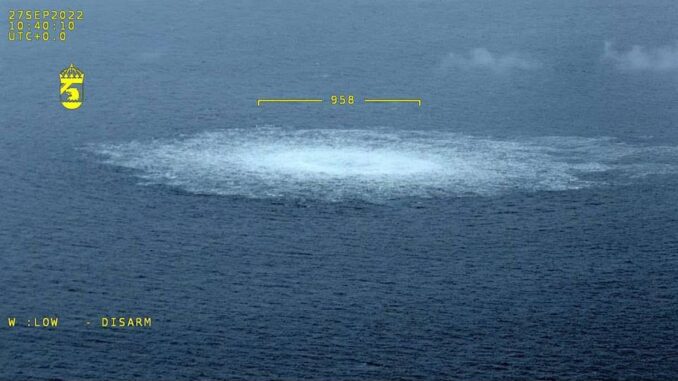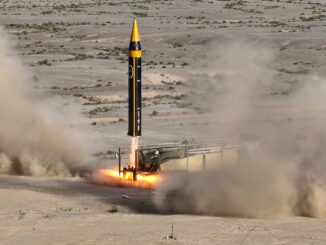
So whodunnit? Who destroyed the Nord Stream 2 at three minutes past midnight on September 26, 2021? Explosives set 262 feet below the surface of the Baltic caused a blast registering 2.5 on the Richter Scale. It ripped apart the $11 billion gas pipeline that fed Russian gas directly into Germany and Western Europe and blew up global geopolitics as well.
So who was it? The Russians? The Ukrainians? The Americans? The Danes? Norway? Poland? Israel? The British? One year on, as speculation mounts and investigations continue, it’s unlikely any nation will be definitively fingered. And since allies will always protect useful proxies, at best, we can expect a scapegoat.
Seymour Hersh, American military muckraker, alleges US Special Ops were to blame. He claims US Navy divers planted the TNT during the 51st BALTOPS22, a Nato exercise involving “47 ships, 89 aircraft, and 7,000 personnel in the Baltic Sea” which was conducted some three months before the incident.
Certainly, President Biden, fuelled these rumours as he stood alongside German Chancellor Schultz and told a press conference that if Russia invaded Ukraine he would make sure that “there will be no longer a Nord Stream 2, we will bring an end to it”. When a journalist asked how he would do that since Nord Stream 2 is in Germany’s control, he replied: “I promise you we’ll be able to do that”. The Chancellor nodded: “We are united”.
Russia, meanwhile, says it was BALTOPS22. But many suspect Putin is the guilty party. Russia has a long history of taking a “scorched Earth” approach in war, meaning they see value in damaging their own valuable assets in order to deny others the possibility of using them. They did this in the war of 1812, and during Hitler’s Operation Barbarossa when they destroyed their own crops and equipment. They are also, according to Ukraine, doing it today in Bakhmut.
Germany’s investigators point to a 50-foot pleasure boat called The Andromeda which hovered near the explosion site at about the time the explosives were thought to be set in place. The six crew were apparently all travelling on professionally forged passports and Germany’s investigators found traces of explosives aboard. It seems the vessel had been hired in Germany by a Polish entity, thus raising the possibility that it was the Poles. The New York Times has suggested that The Andromeda may have been occupied by the Ukrainians. Others gossip that Israel’s Mossad was behind it. They are usually attributed with the most successful intelligence capers, especially when no other answers can be found.
Other investigators discovered that Denmark’s P524 Nymfen naval ship and several Russian naval vessels approached the detonation location at the same time on September 21. Strangely, all turned off their transponders and disappeared from satellite signals. On September 22, a Swedish surveillance aircraft and a Swedish Corvette naval vessel also converged on the same spot.
Then there was the 600ft Greek-flagged Minerva Julie which was laden with Russian oil. It was heading to Rotterdam when it suddenly stopped and hovered over the exact same site at the same time for seven whole days. They say they were awaiting delivery instructions. Then it turned around and went to Tallinn and St Petersburg instead of Rotterdam. The question seems to be “who wasn’t there?” It’s straight out of an Agatha Christie novel: there are multiple suspects, each have compelling motives and plausible alibis.
The confusion is exacerbated by the fact that official investigators in Denmark, Sweden and Germany are not sharing information with each other. They are all silent, not only because they aren’t ready to defend their findings but also because Europe finds itself in the biggest upswing of spy games since the Cold War. Russian spies are said to have infiltrated the Scandinavian and Baltic countries as well as Germany itself.
But in our feverish determination to name the culprit, we are losing sight of what that explosion illuminated. The world is teeming with plausibly deniable mercenaries — armies of highly skilled, war-hardened professionals. Some are in-house “Special Ops”, and some are former military personnel who are now guns for hire. It seems very likely that whoever carefully rigged the Nord Stream 2 to blow came from this kind of professional background.
The James Bond behind this explosion will not be in the SAS. He will be working in, or retired from, the SBS (Special Boat Services) or Russia’s GUGI or the Danish Frogman Corps. Or possibly this scuba diving demolition expert will be from the Swedish Röjdykare, Norway’s Minedykkerkommandoen or Israel’s Shayetet 13. Alumni from all these are quietly for hire. And they won’t be wearing uniform. Or at least not the uniform of the nation that hired them.
The Geneva Convention has lost all relevance today as military doctrines have radically changed, allowing false-flag operations to haunt modern geopolitics. Both Russia and China have a strategy that calls for unrestricted or unlimited warfare. This means “anything goes”. Anything can be weaponised, including food, energy and civilians. And it means that pitching up without insignia, or in someone else’s insignia, is no longer out of bounds.
But why assume that a state actor was behind the sabotage? We live in a world where non-state actors dominate the landscape of geopolitics. Why is it so hard to imagine that the culprit might not have been a nation but a corporation or even a Machiavellian sort of billionaire? Everyone assumes that a state was behind the sabotage because the methodology and equipment were so advanced. But states increasingly share their capabilities — such as Pegasus, the snooping software that extracts everything from your phone — with private contractors and even civilians with no discernible ties to military or intelligence organisations. The appeal of the untraceable connection is perhaps the most important reason nations increasingly work with private contractors.
It is also true that the global debt burden globally has placed increasing pressure on militaries and intelligence services to cut costs and move costs off the books, incentivising outsourcing. James Bond wouldn’t work directly for the British Government anymore. He’d be a contractor. Similarly, Erik Prince, America’s most visible expert in this domain, works for many governments and not just for the US. Private individuals have become outsourced agents.
We’re seeing examples of this everywhere. The Wagner Group was once President Putin’s plausibly deniable private militia. America has Blackwater or Academi to name only two. Even the Danes seem to use private military contractors these days. Years of wars in the Middle East have given rise to a cadre of people with a certain set of skills. Did we really think they’d retire to a nice suburb, especially when there is so much money bidding for their services?
These highly trained professionals are perfectly capable of executing all kinds of tasks in other countries. India’s much feared Special Group has been accused of an assassination in Canada. Russia insists Nato has deployed Special Ops in Ukraine.
But regardless of who sabotaged the pipe a year ago, it’s time to ask how modern wars are being conducted. Are we witnessing the privatisation of warfare, whereby public authorities outsource the pursuit of national interests to private parties? Special Ops across Nato have been complaining that they are over-deployed because they are so capable and relatively cheap. But should nations be relying on Special Ops, whether official, retired or mercenary status, to achieve national security objectives? There’s always a limit to outsourcing. With Nord Stream 2, we seem to have hit that limit.
Even more worrying is the fact that the explosion marked a definitive turn from decades of land wars to a world dominated by naval warfare. For it’s not just energy pipelines that are being targeted, but also internet cables. Consider the Svalbard internet cable cut on January 6 2022 (an interesting day for many reasons). A mega-yacht was hovering above the fastest internet cable in the world when some five kilometres of it went missing. Luckily, somebody had put a backup cable in place. Otherwise, cutting that cable would have caused Western satellite-based missile and weapons guidance systems to fail. More seriously, it would have shut down the internet and brought about the end of UberEats.S
Was the mega-yacht a Russian military vessel? It was a plausibly deniable vessel, even though it had a submarine embedded in its hull. The Norwegian military seized it but eventually had to let it go due to lack of evidence that it was involved in the cable cuts.
Ever since, the world has witnessed a wide range of subsea internet cable cuts. Last October, for instance, the Marseille cable, which connects the US, Europe and Asia, and the Shetlands-Faroe-Islands cable were both cut in October 2022. The latter is central to keeping track of Russian subs passing through the GIUK Gap (Greenland Iceland UK Gap) at a time when concerns about the possible use of nuclear weapons is being overtly threatened. Yet the media assumes this subsea cable warfare doesn’t matter because people think WIFI comes out of thin air, while the superpowers don’t want to admit to the vulnerability.
But if modern society cannot function without subsea infrastructure, what is the strategy for defending it against such attacks? The riddle of the Nord Stream explosion, whether or not it is solved, invites us to think about an ocean of new possibilities.
ENB Top News
ENB
Energy Dashboard
ENB Podcast
ENB Substack



